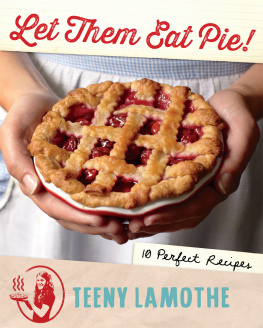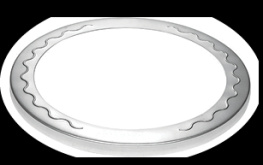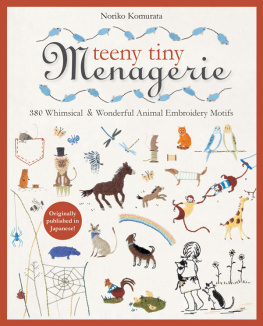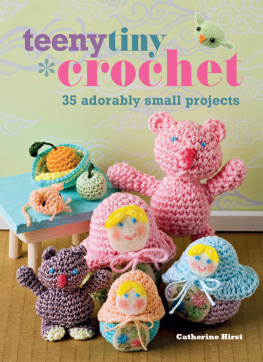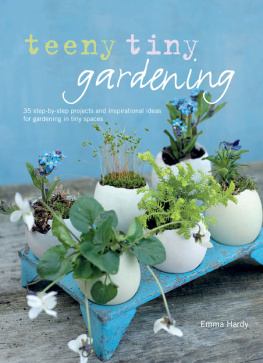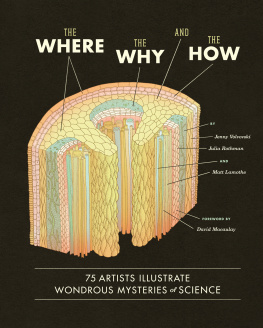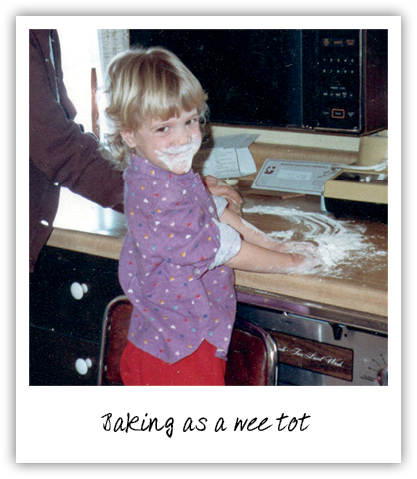Chapter 1
The Elements of Crust
One of my most vivid childhood memories is of perching on a tall kitchen stool next to my mom, wielding my miniature rolling pin in an entirely sincere attempt to imitate her fluid crust-rolling movements. My moms knack for making a good pie crust always made anything not homemade seem a bit silly. She would roll out the crust with ease, occasionally letting me help by using my little fingers to crimp the edges, and would always press the leftover dough into the tiniest of tins, sprinkle it with cinnamon sugar, and bake it off for snacking later. My mom is the reason I never felt any trepidation when endeavoring to make a pie. When I moved to Chicago she sent a kitchen start-up kit that included a pastry cutter, a rolling pin, and a pie plate. She encouraged the baking of pies for birthdays, apologies, and holidays; anything and everything was a good enough reason for pie.
In pie everything starts with the crust. It is the foundation, the base, and can make all the difference between a mediocre, slightly soggy, sometimes surprisingly chewy slice of pie and one with a light and flaky crust thats still sturdy enough to envelop a decadent filling. When you start with a good crust, everything else seems to fall into place. Had I not grown up baking with my mom, I imagine I would have had a healthy dose of fear when it came time to attempt my first pie crust. Instead, I just did it, and then kept on doing it until I got good at it. It took time and patience, and I definitely threw away plenty of overworked dough, but in the end I learned how to make a crust I could proudly call my own. I started with my moms favorite recipe, which calls for shortening, all-purpose flour, and warm water. While I found a certain ease with that recipe, Aaron wanted a crust with a little more character and brought home a bag of whole wheat flour to play with. So in went the whole wheat flour. To complement its slightly nutty flavor, I added a little butter for richness and vodka to help with the flakiness (dont worry, the alcohol cooks out). I tinkered and tweaked until my taste buds (and Aarons) were satisfied.
With my signature recipe in my back pocket, I was especially excited to see how other bakers tackled this most essential pie element. Each of the shops on my tour had their own special way of doing things, whether it was using a very specific type of flour; vinegar instead of vodka; all butter, all shortening, or some combo of the two. No matter what ingredients or methods they chose, they all shared an unwavering pride in their crusts. Which is the way it should be: There is something undeniably rewarding about mixing together a batch of crust from scratch.
At least, its undeniably rewarding until it doesnt work; dealing with temperamental dough is just the worst. After my Tour of Pie, I moved with Aaron to Washington, D.C., and during my first few weeks of living there, every batch of dough I made was incredibly difficult to roll out. Each one fell apart before I could even get it into the tin, and soon I was banging my head against my new cupboards in frustration, taking (large) sips of (cheap) vodka to get through the traumatic process. Aaron suggested I change one variable at a time, and he drew up a pie chart to help me figure out what the problem was. I tried combining flours. I tried using different mixing methods. I even tried leaving water out on the counter to let the chlorine evaporate before using it, which in retrospect was the silliest of everything I tried. It turns out that because my D.C. kitchen was smaller than my previous one in Chicago, it tended to retain any and all excess heat and humidity in the air, making for some very melty crust dough. The solution was to start refrigerating my shortening and letting my dough rest in the fridge a little longer. With those few changes, my crusts began to roll out beautifully.
I was surprised that such a small detail, like the few degrees difference of my tiny kitchen, could make such a huge difference in my dough. But I learned a valuable lesson about the importance of trial and error and also of sticking with it. Making a homemade crust is something I got better at and more confident about over time, and Im sure the same will be true of you. To give you a head start, here are a few things I learned that will help you turn out perfect crust every time:
The 5 Commandments of Crust
- Start with ingredients that you love. I have a crush on whole wheat flour because I love the nutty flavor and toothsome texture it imparts. However, whole wheat flour can be temperamental on its own, so I like to tame it with some all-purpose flour. For fats, I go with butter, which makes the crust tasty, and shortening, which makes it flaky. After testing and tinkering with different flours, Ive homed in on a few favorites, which youll see described in the following .
- Give yourself enough time. I find that when I rush, I end up adding too much flour or too little fat and in the end am left with a stubbornly unworkable lump of dough. Most crust recipes call for a chilled resting period for your completed dough as well, and Ive found that this step is essential. Once Ive made several batches of dough and wrapped the individual disks in plastic wrap, I let them sit in the refrigerator for at least an hour (and usually overnight) before attempting to roll them out. The longer the dough rests in the refrigerator, the easier it becomes to work with. If you try to roll out a crust when its too warm, it will fall apart and youll end up just getting frustrated. You can even make it the day before you plan on baking, as I often do, to give it extra time in the refrigerator.
- Chill a couple of your key ingredients. Ive had people swear that a good pie crust is absolutely impossible unless you use the coldest possible ingredients. This is somewhat true: Cold ingredients do make the dough easier to work with in the long run. But they dont have to be rock solid or absolutely frigid to make a good dough. Its all a balance when youre working with pastry. I never like to fist-fight with frozen butter in order to obtain those perfect pea-size pieces, but at the same time, the colder the butter, the more it maintains its shape, which ultimately leads to those flaky layers we all adore. So I tend to split the difference by storing my butter and shortening in the refrigerator to keep them cold, then letting them warm on the counter for five minutes before making dough. That way theyre not stubbornly stiff when I go to cut the fats into my flour. I also prefer to use ice water and/or chilled vodka rather than tepid tap water. While I was in Ithaca, New York, on the Tour of Pie, my friend Alyssa put her flour in the freezer to chill it before we made our crust. Its not a practice I picked up because I happen to have the smallest, most jam-packed freezer in the world, but its certainly something to keep in mind if you have the space.
- Dont overwork your dough. Its incredibly squishy when you mix it up, and I am all for using your hands to work everything together, but resist the temptation to knead the dough. Its not that kind of dough, so the more you touch it, squish it, squash it, and roll it around the stronger the gluten becomes and the tougher your crust will be.

